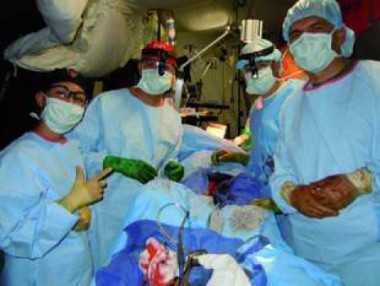Emergency
Szöveg: Gábor Kálmánfi | 2011. január 20. 14:42Before deploying to Afghanistan, Lt-Col. Dr. István Toperczer had not held a scalpel in his hand for ten years, but the ISAF troops deployed there relied on him as a surgeon as well. On one occasion, following a complicated surgery lasting several hours, he was already on his way early in the morning in a convoy to provide medical support. Furthermore, his team saved the life of an EOD dog as well…
Like everybody else, Lt-Col. (Med.) Dr. Toperczer, chief physician of the Medical Centre at the HDF 59th Szentgyörgyi Dezső Air Base, had volunteered for the ISAF mission in Afghanistan. He was posted to the area of operations (AO) as the Commander of the Medical Center of the HDF Provincial Reconstuction Team (HUN PRT). It should be added that this was not his only assignment, as troops (of any nation) who get wounded in action (WIA) during the operations conducted in the HUN PRT’s area of responsibility (AOR) also receive primary medical care at Camp Pannonia, in Pol-e Khomri. In these cases the HUN PRT’s medical cell usually partners with the US Forward Surgical Team (FST), which is stationed in the camp to support the ongoing operations , in providing medical care.

The FST is tasked with performing the most important life-saving and stabilizing surgeries on the WIA who are transported into the camp directly from the AO. Their objective is to stabilize very seriously injured (VSI) personnel and prepare them for further transportation. While cooperating with the US FST, it turned out that Dr. Toperczer is actually a qualified surgeon, so on learning this the FST staff brought another operating table into the operating room inside a tent because they wanted to provide better and faster treatment with a mixed team.
“For more than a decade, I had not performed a surgery the way I had done in the county hospital in Hungary. However, it was as if I had laid down my scalpel just the day before. My experience as a surgeon helped me a lot in responding to unforeseeable emergencies. While in Afghanistan, I had the opportunity to make use of all the skills I have acquired", Dr. Toperczer said.
Once it happened that five casualties arrived at the camp at the same time. Two of them had to undergo surgery immediately, while the Emergency Medical Technician (EMT) and the army doctors in the outpatient department were treating the less serious cases. The lieutenant-colonel also told us that in Afghanistan he was not able to apply the type of surgical methods that he used to apply as a surgeon in peacetime. In the AO, the primary objective must be to save lives, so a surgical team cannot perform any surgeries that would be time-consuming or would require sophisticated instruments because they have a number of other patients waiting for treatment.
“In certain cases we had no choice but to amputate some limbs fractured by a blast. Had we been working in peacetime, perhaps we would have performed a long and complicated surgery and perhaps there would have been a chance to save some of those fractured limbs. However, in the AO there is no time for this type of surgery.

Nevertheless, he faced a perhaps even greater professional challenge when he and his colleagues were tasked with operating an EOD dog. Due to transportation trauma, the stomach of the unlucky dog turned around its own axis. There is a veterinary doctor on duty in the AO, but at that time he was in another garrison and the helicopters were not available on time. The only thing Dr. Toperczer’s team could do was to start the operation, during which a US army surgeon was consulting the vet both by phone and via their own military internet. The operation was a success. They saved the life of a trained dog, a “soldier" worth millions of HUF, not to mention the fact that the handler of the dog was also able to continue with his tour of duty in the mission that he had been training for earlier for six months. What is more, this EOD technician and his canine companion will most certainly save further lives through their work.
Photo: MH PRT-archive